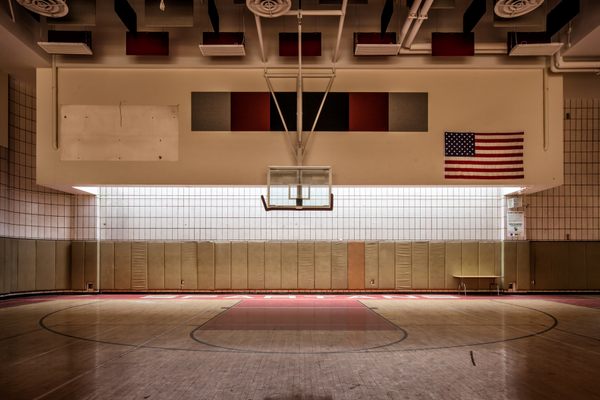Forest Glen: Photographs of a Seminary in Arresting Decay
Inside Forest Glen (all photographs by the author)
Hidden mere yards from the Capital Beltway surrounding Washington, DC, lies a jumble of dilapidated ruins, construction, and million dollar homes all strewn together.
In 1887, Ye Forest Inn was built, and tourists flocked to the resort to escape the swampy summers of Washington, DC. To attract patrons year-round, the inn added a gambling hall. This lasted only a few years until 1894 when the inn changed hands and was converted into a girls’ boarding school, renamed the National Park Seminary.
A book of international architectural plans obtained at the Chicago World’s Fair in 1894 was used as inspiration for many buildings constructed on campus. Elaborate causeways and covered walkways interconnected most of the campus. These enclosures made the seminary seem even more isolated than before; the girls were now sheltered physically, as well as socially.
In the 1920s, enrollment peaked with more than 400 students, some with familiar last names like Kraft, Hershey, and Chrysler. Tuition was double the Ivy League schools of the time. However, during the Great Depression, enrollment dropped to as low as 40 students.
In 1942, under the War Powers Act, the Army seized the Forest Glen property. The site was to be used mainly for recovering amputees from WWII. During the Korean and Vietnam wars, the Forest Glen Annex housed soldiers returning home with mental trauma and shell shock.
During their military tenure, several buildings were demolished to build a mouse-breeding colony and animal research lab. There were signs reading: “Shoot Escaping Animals.” The Army also wanted to construct a medical waste incinerator, but there was too much community outcry.
In the early 1970s, deterioration of the grounds and building neglect became evident. By 1978, all patients were removed from the Forest Glen, leaving only a few buildings occupied. In 1989, the Save Our Seminary association (a group of preservationists and local community members) halted a plan by the Army to raze the site, and in 1990, SOS helped obtain authorization for $3 million in federal aid to repair the historic buildings, but restoration was never initiated.
A fire set by an arsonist in 1993 caused the Odeon Theatre at the Forest Glen to burn down to the ground. Repair requests for the sprinkler system had been sent to the Army prior to the fire, but no response was elicited. The Forest Glen had become a collection of dilapidated buildings due to the years of neglect.
When I was a high school senior in 1999, I went on my first photo adventure to the seminary. I climbed up a three-story fire escape to enter through the attic where I found discarded army jackets and a closet full of psychiatric patient files from the early 1970s. This first visit to the Forest Glen had me intrigued and I returned many times throughout college.
During graduate school I discovered that in 2003 the private developer Alexander Company took over the site and was in the process of transforming the Forest Glen into a residential community. The current fervor for historic preservation has given new — if ambiguous — life to the National Park Seminary. Adopting the aesthetics of various cultures evolved into the faux vision of the Forest Glen’s latest incarnation. The bulk of the campus has been turned into apartments and condominiums. There were even brand new houses built in the style of the old buildings. It all comes together as a cheap knock-off of the original. The Forest Glen has come full circle and has been redesigned as a self enclosed community once again.
The Save Our Seminary association still offers monthly tours from early spring to late fall.
NATIONAL PARK SEMINARY, Silver Spring, Maryland














Follow us on Twitter to get the latest on the world's hidden wonders.
Like us on Facebook to get the latest on the world's hidden wonders.
Follow us on Twitter Like us on Facebook